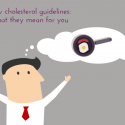Five Facts About Red Meat

Americans eat a lot of red meat – nearly 200 pounds per person in a year according to the U.S. Department of Agriculture. While red meat consumption is linked to increases in heart disease, it also contains valuable nutrients essential for a healthy body. A new study published this week presents one more reason why we should moderate our intake of red meat and stick with lean cuts in small portions.
FACT 1: The carnitine in red meat can increase heart disease risk.
It’s not only cholesterol and saturated fat that can raise heart disease risk. A compound called carnitine can also increase your risk. Carnitine is an amino acid. It is normally found in red meat but our bodies also produce it. The study showed that when you eat red meat, the carnitine is metabolized by gut bacteria to a compound called TMAO. Higher levels of TMAO are associated with increased risk for heart disease. The more meat you consume, the higher your levels of TMAO.
FACT 2: Red meat is rich in iron, vitamins B12, and zinc.
Red meat contains 10 important nutrients. Iron is a key nutrient, especially for teenage girls and women of child-bearing age. The vitamin B12 in red meat is easily absorbed. Vegetarians and vegans often need to supplement their diet with both iron and B12. Zinc supports a healthy immune system.
FACT 3: Red meat includes pork.
Is pork “the other white meat” as the popular ad says? Not according to the USDA. When cooked, fresh pork turns white, but it is a red meat with a similar nutrient profile. Select lean cuts without visible fat.
FACT 4: Pick from more than 25 lean cuts of red meat.
You can benefit from the nutrients in red meat without the artery-clogging cholesterol and saturated fat found in fatty beef cuts. You have lots of healthy choices. Look for loin, sirloin, and round cuts, including lean and extra lean ground beef.
FACT 5: Grass-fed beef is leaner than grain-fed beef.
The natural food source for cows is grass, but most cows now eat a grain-based diet. This DOES make a difference in the beef product you’re eating. Grass-fed beef is leaner with a healthier fat profile compared to grain-fed beef. It’s pricier, but so flavorful that a smaller portion will satisfy.



